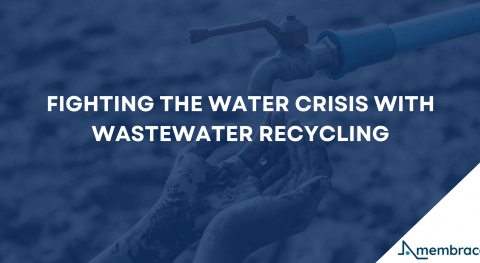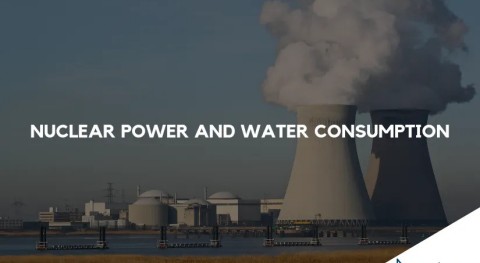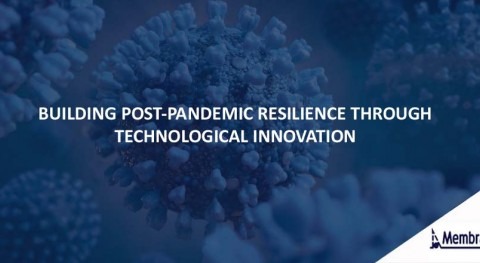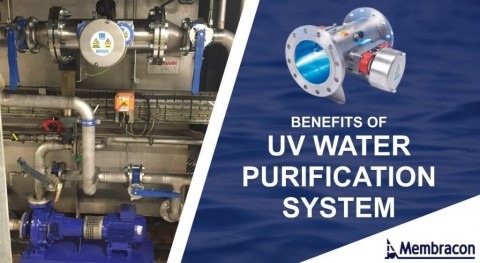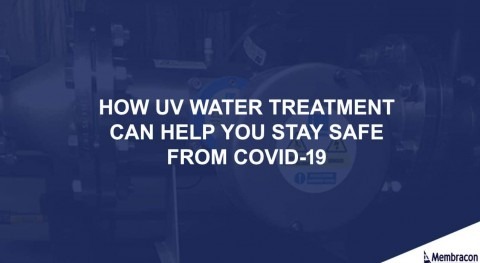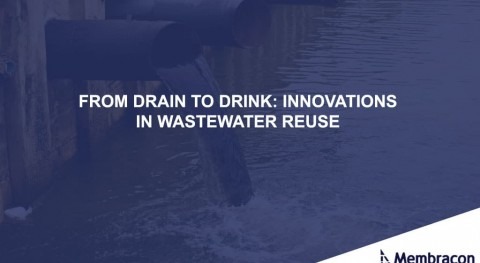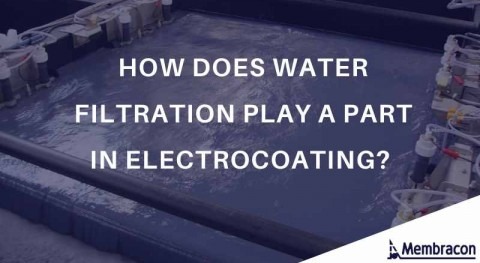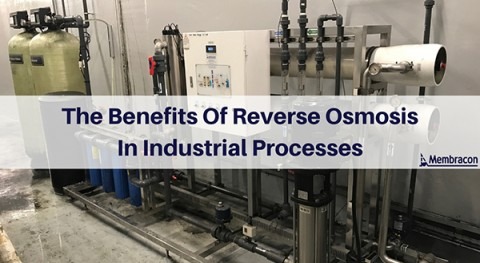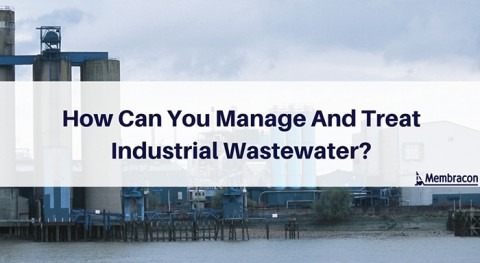Dependent on your raw water, many different industrial water filtration systems can be used to remove impurities, solids and chemicals. Reverse osmosis is becoming an increasingly popular choice due to the fact it can remove more than most other systems.
Sometimes a combination of systems are used, this depends on the quality of the water you have, and the quality you need to achieve for your specific requirements.
Companies are becoming more aware of the impact their wastewater can have on the environment if not disposed of correctly. Just last week we saw Southern Water fined £126m and is under criminal investigation for the incorrect management of wastewater.
Below is everything you need to know about Reverse Osmosis including how it works, what sectors it can be used in and the benefits of implementing it.
What is Reverse Osmosis?
It’s a process in which raw water passes through a system that removes impurities and is often referred to as RO.
The system has cutting edge designed membranes that remove the impurities without the use of chemicals, resins or ion exchange beds.
Raw water or towns water is water that has not been treated or had any elements/minerals removed. Water comes into the RO system via a break tank or a fed from the mains. Depending on your geographical location the quality of your incoming water will differ.
Unlike other filtration systems that operate on a low-pressure water system, RO requires a higher pressure pump to drive the water through the membranes. This is due to it being able to remove more impurities than other filtration options.
The RO process improves the purity and quality of the incoming water supply by reducing the micro-Siemens and total dissolved solids (TDS).
Below is a diagram to show the capabilities of RO in comparison to Microfiltration, Ultrafiltration and Nanofiltration.

How Does Reverse Osmosis Work?
To understand how reverse osmosis works, lets first explain how osmosis works.
Let’s start with 2 cups, one has plain water in, the other has water and contaminants dissolved into it. A U-tube is then used, which is a beaker-shaped in a U-shape.
Right in the middle of the tube, imagine a bit of Gore-Tex that cuts the U in half. Gore-Tex is our “semipermeable membrane.” Gore-Tex is thin plastic, dotted with a billion tiny little holes that allow water vapour to pass through, but liquid to stay out.
In one arm of the U-tube the plain water is poured, in the other is the contaminated water. This is when the osmosis process begins. The level of liquid in the contaminated water arm will slowly rise, as the plain water moves through the Gore-Tex, to make both sides of the arm more equal in a contamination-to-water ratio.
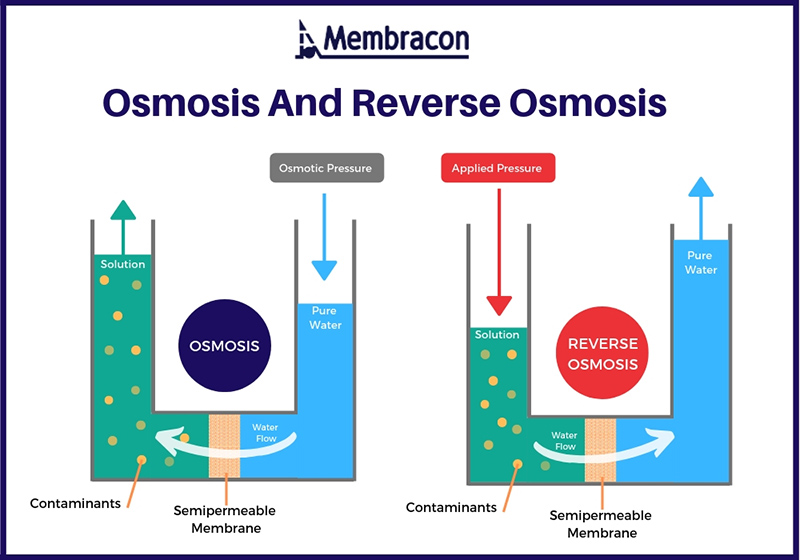
This is due to the water finding an equilibrium. Because the one side of the arm is crowded with contaminants, pure water from the other side decides to move on over to make the concentration more equal or until the osmotic pressure (the pressure that happens as the molecules move is reached.
In osmosis, a lower-concentrate solution will filter its solvent to the higher concentrate solution. In reverse osmosis, we are just reversing the process, by making our solvent filter out of our high concentrate into the lower concentrate solution. So instead of creating a more equal balance of solvent and solute in both solutions, it’s separating out solute from solvent (the contaminants from water). These are more commonly referred to as concentrate and permeate.
This isn’t something that solutions really want to do, so the pressure is added to the equation to make reverse osmosis occur. Pressure forces the water to pass through the membrane, removing the impurities in the water.
What Sectors Can RO Be Used In?
Water is required in most manufacturing applications, it can be used to clean other machinery, process parts, produce consumables, wash out packaging before products are inserted and more.
RO can be used in the following sectors:
- Automotive
- Food & Beverage
- Aerospace
- Pharmaceutical
- Agriculture
- Finishing
- Industrial
Automotive Industry
Water is a key element of the entire process of producing, maintaining and cleaning a vehicle and the components that comprise them. In the production stages of creating a vehicle, water usage is at its highest.
The wastewater from producing a car can contain metals, oils, grease and harmful chemicals from paint residue. If not treated properly these products can cause long-term damage to the environment and can be dangerous if they enter the main water system.
Reverse Osmosis can be used to produce the water needed in the initial part of the process and also at the end of the process where the wastewater can be processed again using RO. Once the water is cleaned and the waste products removed and disposed of correctly rather than just flushed away, it can then be reused in the production process, reducing waste and usage of water.
This is ideal for automotive companies looking to save money on resources and storage costs for water. It also conveys a more responsible water-practise mentality, this is a growing concern for business owners as environmental issues are bigger than ever.
How Can RO Be Used In The Food And Beverage Sector
The food and beverage industry is highly regulated therefore water usage is naturally high. Not only as water is a major ingredient in food and drinks but it’s also an essential part of maintaining food hygiene standards.
It’s also used to prevent the spread of harmful bacteria that could be dangerous to staff and consumers. As the food is prepared, pathogens from meat and poultry need to be removed properly as they can spread onto other surfaces and kitchen equipment.
Pure Water is essential in the sterilisation of kitchen preparation areas to ensure the bacteria doesn’t reach other areas when it could cause harm.
The Food Manufacturer claims that this sector is currently using 430 million litres of water per day as part of cooking, cleaning and preservation of food and beverages.
There are major cost savings to businesses in the long run by implementing water filtration systems into their manufacturing process. Savings of such volume can be reinvested into training staff, hiring more employees and growing businesses.
This can be achieved without the sacrifice of food hygiene standards which many businesses in the sector rely on for reputation and success.
RO in Aerospace
The aerospace industry is one of the fastest developing industries of today. It uses huge volumes of water on a daily basis as it services projects from commercial, defence and space exploration backgrounds.
Due to the nature of the aerospace industry, a highly precise system is required for all matters around production and cleaning. This includes components that make up an aircraft.
To reach the high standards required, a high volume of water is used across the sector. Cleaning one commercial aeroplane just 4 times every year can use up to 13,000 litres of water. Once used this water is flushed down the drain taking all the cleaning agents and grime from the process with it.
If this was properly managed the chemicals could be correctly disposed of rather than washed to drain. The water would undergo a cleaning process such as reverse osmosis to remove any bacteria and make it fit for reuse. This way the water can be recycled back into the system to be used again.
RO In The Pharmaceutical Sector
The pharmaceutical sector uses and wastes a naturally high volume of water. This is due to the chemicals being used in the production of medical products for both human and animal use.
As well as medication this sector also covers the production of chemical-based products such as cleaning agents, which require a lot of water throughout the process of producing and distributing them.
Implementing a wastewater treatment system can help to remove chemicals and bacteria from water, allowing businesses to reduce the overall amount of water they’re using.
Producing purified clean water isn’t just vital for the reduction of usage, it's also critical to ensure that when it’s recycled that all harmful bacteria and contaminants have been removed.
If not, there is a high risk of cross-contamination with other products. Errors can be costly to rectify and pose a threat to health and a business’s reputation.
How Can RO Be Used In Agriculture
The dairy and agriculture sector is heavily regulated for hygiene standards. This is due to the strict disease control and the volume of produce that’s used as food such as milk or eggs.
Water is also used as part of the growth and management of crops, the cleaning and sterilising of farm equipment and the cooling and storage of fresh produce.
In the UK, it takes almost 41 billion litres of water to produce one years’ worth of milk. Water is an essential part of keeping cattle healthy so they produce high volumes of good quality milk.
Part of this large volume of water is used to keep dairy sheds clean and prevent the spread of harmful bacteria. If bacteria were to spread and cause illness it could have a catastrophic impact on a farm if a herd was to be affected.
With the growing concerns of preventing disease, the cost of installing a water treatment system could far outweigh the damages to a business if harmful bacteria were to infect livestock.
The UK government have strict regulations on managing the risk of disease within this industry so its vital that businesses manage their water as part of this.
Reverse osmosis systems form part of a water treatment solution that could be invaluable to dairy and agriculture businesses as it reduces the presence of harmful bacteria and overall expenditure needed to generate clean water for the business over time.
The correct water treatment can remove mud and harmful bacteria from the water, which could lower the risk of illnesses within livestock and drive up the quality of the produce.
Another option is to recycle the water back into the facility.
RO In The Finishing Industry
Dependent on the industry the finishing part of production can be one of the most demanding when it comes to the quantity of water being used.
In order to ensure the end result of the product is to the highest standard and is consistent with previous colours its inevitable that the usage of water will be high.
The nature of the finishing process can be chemical, mechanical or a smart finish. Dependent on this there will be certain products such as oils and substances that end up in the wastewater. It can also include metals and paint residue.
When it comes to specific sectors such as the automotive industry, the paint and finishing process alone can use more water than all other stages.
Poor quality water going through a system not only affects the environment but it can also affect the quality of the finished product.
RO In Industrial Processes
Manufacturing and industrial plants use high volumes of water as part of their everyday processes not only for production but for the cooling of products and equipment.
It’s also used for cleaning and storing specialist products in order to maintain the expected levels of health and safety.
Due to the high volumes needed, water scarcity is often a problem for those within the industrial sector.
As high volumes of water are constantly required, areas begin to experience problems with shortages. Water companies have also been known to apply large surcharges to bills for mass water use.
Installing water treatment facilities into an industrial plant can help drive down the environmental damage and cost caused by wastewater. It also prevents the issue of water scarcity, giving you more control over your water.
Reverse osmosis units are highly beneficial to the industrial sector. The cleaning of water makes it reusable, this then limits the amount of water contamination.
What Are The Benefits To Using RO
There are a number of benefits RO can provide to industrial processes and why its one of the best water filtration systems. Benefits of implementing RO include:
- Environmental
- Cost
- Health & Safety
- Maintenance
Reverse osmosis is one of the greenest solutions for industrial wastewater. It captures impurities allowing you to dispose of them correctly.
RO doesn’t require the use of harmful chemicals so there is less hazardous wastewater.
Alternative water filtration processes require the use of chemicals. The price of acid and caustic solutions continue to rise as membrane elements used in RO decrease.
The primary cost for RO is electricity; modern water filtration systems consume little energy so operating costs are relatively low.
As there are no hazardous chemicals needed, the health and safety benefits of implementing RO are huge. Traditional resin-based ion exchange systems use highly dangerous acids and alkalis that pose a threat to those handling it.
It also limits the risk of chemicals being stored on-site, providing a safer working environment.
RO is a self-contained unit that maintains itself. It self-cleans and needs minimal operator interaction, only regular monitoring.
Membranes can last up to 2-3 years depending on varying factors such as the quality and quantity of the water being fed into the RO system.
There is limited downtime when it comes to reverse osmosis as membranes can be replaced within hours.
Can RO Be Used Commercially?
Water filtration systems such as RO are being used more commercially due to the success they have in the industrial process.
The process of installing an RO system for commercial use mirrors that for industrial use as each system is bespoke to the water issue. Find out more about how RO can be used commercially.
Conclusion
Reverse osmosis uses cutting edge modern membrane technology rather than chemicals to treat and manage wastewater.
As more companies become aware of the implications that incorrect wastewater disposal can have to their businesses reputation, they will ultimately have to decide how best to manage their wastewater.
Membracon prospers to ensure each system is the best for their clients. This is why every unit is fully bespoke, designed and built to suit each customer's individual requirements.
The first step in understanding your industrial water treatment requirement is to analyse your raw or wastewater, depending on your requirements. This way you can establish the water quality you need to achieve. Membracon offers a free water analysis test to help you with this process.




